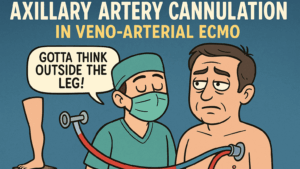Acute Type A aortic dissection (AAAD) is a life-threatening condition, particularly when complicated by coronary malperfusion. The optimal treatment approach remains debated, particularly concerning early coronary reperfusion strategies. This study retrospectively evaluates the impact of transportation type—direct transfer versus referral—and the effects of preoperative coronary interventions on surgical outcomes in such patients.
Background and Rationale:
AAAD with coronary malperfusion presents significant management challenges due to its time-sensitive nature. While early reperfusion may improve myocardial salvage, practical considerations—such as access to specialized care and treatment pathways—vary significantly. Additionally, mechanical circulatory support, including peripheral extracorporeal membrane oxygenation (ECMO), is frequently employed, but its effectiveness in improving survival remains unclear. This study investigates these factors to provide insights into optimizing patient care.
Methods:
A total of 70 patients undergoing emergency surgery for AAAD with coronary malperfusion (excluding those with cardiac tamponade) were analyzed from a 27-year period (1997–2024). They were divided into two groups:
- Direct transfer group (N = 26, 37%): Patients were transported directly to the surgical facility.
- Referral group (N = 44, 63%): Patients were initially treated at another hospital before being referred for surgery.
The study assessed preoperative interventions, hemodynamic stability, and patient outcomes. A particular focus was placed on patients undergoing coronary angiography (CAG), percutaneous coronary intervention (PCI), and ECMO use.
Key Findings:
- Overall In-Hospital Mortality:
- The total mortality rate was 27%.
- No significant mortality difference was observed between direct transfer (23%) and referral (30%) groups.
- Preoperative Coronary Angiography and PCI:
- Patients undergoing CAG without successful PCI had a notably high mortality rate.
- In contrast, all patients who underwent successful PCI survived.
- ECMO and Hemodynamic Status:
- Of the 9 patients receiving preoperative ECMO, only 1 survived (11%).
- Hemodynamic stability played a crucial role in survival:
- Stable patients: 91% survival.
- Patients in shock: only 46% survived.
- Cardiopulmonary arrest (CPA) patients without ECMO: 46% survival.
- CPA patients with ECMO: only 11% survival.
- Key Risk Factors for Mortality (Univariate Analysis):
- Left coronary artery involvement significantly increased risk (Odds Ratio: 4.0, p = 0.02).
- Shock, coma, preoperative ECMO, and CPR were strong mortality predictors.
- Diagnostic-only CAG without PCI trended toward higher mortality (p = 0.06).
Clinical Implications:
- Preoperative ECMO alone does not guarantee improved survival and may delay definitive surgical repair.
- Timely diagnosis and transport to a surgical center are critical. Delays due to initial management at non-surgical facilities can worsen outcomes.
- CAG without PCI should be approached cautiously, as unsuccessful reperfusion may delay central aortic repair, increasing fatality risk.
- Managing hemodynamic stability before surgery is crucial; peripheral ECMO should not replace early surgical intervention.
Conclusion:
While transportation type did not significantly affect mortality, preoperative coronary interventions and hemodynamic stability were key determinants of survival. The study suggests that prioritizing early surgical repair over delayed interventions such as ECMO or unsuccessful CAG may improve outcomes for patients with AAAD and coronary malperfusion.







